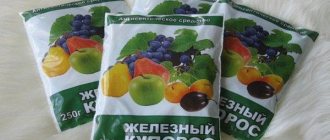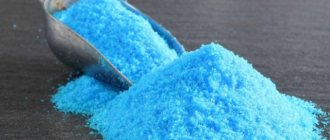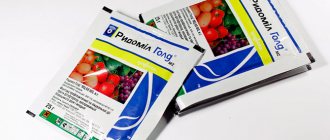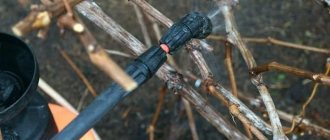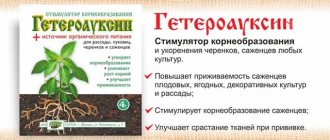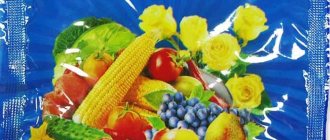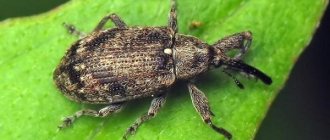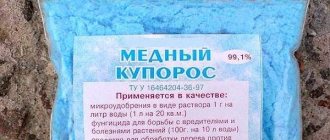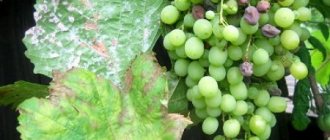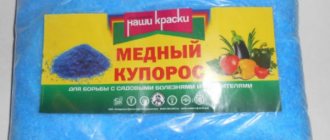Description of the drug
The substance obtained by reacting sulfuric acid with divalent iron molecules is made in the form of turquoise-colored salt crystals. It dissolves well in cold water and is used to combat diseases and pests on grapes. Can be used as a mineral fertilizer when the soil contains insufficient iron. Iron sulfate for grapes is used throughout the world as a means of combating diseases. Not dangerous for humans and pets. The instructions on the package with iron sulfate will help you make the best solution for autumn processing of grapes.
What it is?
Iron sulfate is a solution of ferrous sulfate. Ferric sulfate is odorless and consists of transparent bluish-green crystals. The substance differs:
- good solubility in water;
- low toxicity;
- oxidation under the influence of air;
- low degree of decomposition at high temperatures.
In industrial production, iron sulfate is obtained as a by-product when iron sheets or wires are etched with sulfuric acid to remove scale.
You can prepare the substance yourself by treating scrap iron with a dilute solution of sulfuric acid.
The use of iron sulfate is extensive. In addition to agriculture, it is necessary as a medicine for patients with iron deficiency anemia. It is also used for dyeing fabrics and producing ink.
Iron sulfate is produced in the form of crystalline powder, in bags weighing 150 grams.
How to breed?
To process grapes and combat diseases and pests, it is important to know how to dilute iron sulfate. The substance dissolves well in water, so just pour it into a bucket (10 l) and fill it with water. After mixing the mixture well, pour the diluted fungicide into the sprayer and begin treating the bushes.
Processing the vineyard in the fall often occurs at low temperatures, so it may be necessary to use hot water to prepare the solution. The vine is being processed, so the concentration of iron sulfate can be increased, especially when working with old bushes.
Solution concentration
Depending on the purpose of spraying, solutions with different fungicide contents are prepared: • if it is necessary to destroy harmful microorganisms, you will need to dilute 400-450 g per bucket of water; • when processing to combat lichen or moss, add 300 g of sulfate per 10 liters; • if there is a lack of iron and foliar feeding is carried out on the leaf, 15-20 g of the substance are diluted in a bucket of water; • if the grapes are affected by chlorosis, the bushes are treated with a solution of 5 g of the substance per bucket of water; • to apply root dressing in the fall, it is enough to pour 100 g of vitriol per 1 m2 before digging.
Norm when spraying grape bushes
When spraying grapes in autumn, it is not necessary to dilute a large amount of solution at once. Considering that the work is carried out on the vine, without treating the foliage, the consumption rate of vitriol is 10 liters of solution per 100 m2 of area. For a small garden plot with a small vineyard, 10 liters is enough, but if the solution remains, it can be used to treat trees or the soil around the bushes. The main thing is to maintain the proportions of iron sulfate and water, generously spraying all parts of the plant, especially the depressions in the bark of the old vine. Prepare a solution of iron sulfate for spraying grapes in sufficient quantities, with a small margin. If the vineyard treatment area is 130-140 m2, it is better to make 2 buckets of solution, treat the plants generously, and use the remainder to spray fallen leaves or fruit trees on the site.
Features of autumn processing
After harvesting, the owner of the grapes still has a lot of work to do on the site. It is during this period that the fruit buds of the future harvest will form, so timely pruning and feeding of plants plays an important role. For good fruiting, it is also important to use preventive and therapeutic spraying with iron sulfate
Algorithm of actions and important nuances of processing:
- The first priority is to trim branches and remove debris from the area. The cut areas must be treated with garden varnish or paint, and treatment with iron sulfate will help the rapid healing of wounds and cracks.
- You cannot spray the plant before the leaves fall, because in this case there is a high risk of injury to the bush. Spraying helps to restrain the growth of fruit buds, so they are less likely to freeze later.
- Treatment is carried out only in dry, windless weather to minimize the loss of valuable substances and the need to repeat the procedure.
- After processing and natural drying of the plants, you can begin preparing the winter shelter. For more effective protection against pests, the soil in the tree trunk circle is additionally treated, where larvae and pests can be found.
- To enhance the therapeutic effect, you can mix copper and iron sulfate, but it is better to avoid lime.
You may be interested in: Treatment of currants in the fall from pests and diseases
Spraying with iron sulfate will also help to root grape cuttings in winter. To do this, seedlings with the treated aboveground part are planted in the ground. The upper part of the plant will not develop (one of the properties of iron sulfate is to stop the growth of green shoots), while the root system will begin to actively expand due to the lateral shoots.
When to use iron sulfate
Iron sulfate for grapes in the fall is one of the important treatments for plants against diseases. Autumn spraying of grapes with iron sulfate is carried out after the leaves fall from the bushes. 10-15 days after the leaves fall, winegrowers begin pruning excess growth and preparing the bushes for shelter for the winter.
If you carry out earlier processing, the process of photosynthesis and accumulation of nutrients in plant cells will not be completed. If you delay the pruning date, the risk of bushes being damaged by the first frost increases. After pruning, removing fallen leaves and trimmed sprouts, you can begin treating the bushes with a fungicide in the fall. The concentration of the substance depends on the age of the bushes:
- To treat young bushes, it is better to prepare a 3% fungicide solution. Add 300 g of vitriol to a bucket of water;
- treatment of old grape bushes will be required with a 5% solution. Autumn work is important not only for affected grape bushes, but also as a preventive measure against infection of healthy plants. By treating the vineyard with iron sulfate in the fall, gardeners help reduce the likelihood of diseases and pests occurring on the site in the spring.
Precautions, advantages and disadvantages
This odorless inorganic compound appears as small crystals of a turquoise hue that are highly soluble in water. The chemical composition contains 53% of the active substance (ferrous sulfate). Microfertilizer has the following advantages:
- different purposes of use in the garden plot;
- low cost;
- composition harmless to human health.
Feeding
Obtaining a bountiful harvest depends on the supply of a sufficient amount of microelements to the root system of the plant. The main role in growing grapes is given to ferrous sulfate.
Against the background of ferrum (Fe) deficiency, vegetative processes are significantly inhibited, the growth of new shoots stops, the leaves curl and turn yellow. This phenomenon is observed when the soils on the site are poor. Alkaline soil does not contain enough iron, and only through additional fertilizing can the concentration of this element be increased. Fertilizer in a dissolved state is well absorbed by young plants.
The use of iron sulfate in viticulture is aimed at the active production of chlorophyll and the subsequent accumulation of nutrients. As a result, strong brushes grow and the number of ovaries increases.
Protection from diseases
Fruit bushes are susceptible to the negative influence of insects. After treating the trunks and branches, it is possible to destroy colonies of pests and laid eggs. This product helps fight the most common crop diseases: grape cushion, anthracnose, spotty necrosis (ink blight, dry rot), powdery mildew. Viral microorganisms multiply in the bark and feed on unharvested brushes and leaf debris.
Low-toxic iron sulfate creates an acidic environment to which bacteria are sensitive. The drug, which has fungicidal properties, is used in the treatment of chlorosis, lichen, and moss. Spraying with aqueous solutions is aimed at destroying rot from the bark of trunks.
The substance belongs to hazard class 3, i.e. low-risk for humans. Does not spontaneously ignite, does not explode. If it enters the human body in large quantities, general poisoning, upset of the digestive system and irritation of the skin and mucous membranes are observed. Urgent medical attention is required.
Irrigation must be carried out in calm weather, wearing personal protective equipment.
Can be stored in a hermetically sealed container for an unlimited amount of time. Once opened, it is advisable to use it as soon as possible and protect it from dampness.
Advantages of the drug:
- Non-toxic to humans, plants and animals (in moderate doses).
- Replenishes iron deficiency.
- High effectiveness against fungi is noted.
- Long shelf life.
- Relatively low cost of the drug.
Despite the many advantages, the drug still has a small list of disadvantages.
- If the concentration decreases, it does not produce results.
- Processing time limits.
- The formed film is easily washed off by rain.
- An excessive concentration of the active substance can leave burns on plants.
- Efficacy against viral and bacterial diseases is low.
Iron sulfate is a very effective microfertilizer, which is effective in the prevention and treatment of various diseases and pest attacks. Plants can be saturated by irrigation or added to the soil by digging in the fall and spring.
Iron sulfate is justifiably included in the list of the most popular drugs. When used correctly, it provides good and lasting results. Before use, be sure to read the instructions for use.
Use of a substance for pest control
Ferrous sulfate is used as an antiparasitic substance. A properly diluted mixture of iron sulfate for spraying grapes can quickly destroy eggs, larvae, and the pests themselves laid in the bark of plants. With particularly careful filling of all cracks in the bark, even one operation can destroy half of all larvae.
But the main job of ferrous sulfate is to protect plants from disease. The low toxicity to insects of this drug does not allow achieving reliable results in pest control. Autumn spraying, as a preventive measure against pests, is a completely justified step, but starting in spring, it is better to use more effective preparations to combat insects.
Knowing how to properly dilute iron sulfate for spraying grapes, it is important to understand how to spray the bushes to achieve optimal results.
In the fall, just before covering the bushes for the winter, the grapes are treated with iron sulfate. But before that, you can add organic fertilizer. To do this, add up to 8 kg of rotted manure or compost under each bush. Cut shoots should not be tied into fascines. For best results, it is important to apply the solution to the entire surface of the sprouts and vines.
Be sure to use a sieve to pour the vitriol solution into the sprayer.
We must not forget to use eye protection when carrying out work. And although the solution is not toxic, it is better to use gloves and cover exposed skin. To supply the mixture, do not place a large torch on the sprayer of the fishing rod.
Each shoot and sections of the vine are filled with solution, filling all the voids and cracks. This is why treatment in the fall before sheltering for the winter is so important. You should not worry about the large consumption of the solution. Treated soil under the bushes and the plants themselves will prevent the wintering of diseases, fungi and pests. Therefore, you should not save the solution. You can even slightly increase the concentration of the substance to 7% when processing grapes before sheltering for the winter.
Application
Beginners often wonder whether it is possible to treat grapes with iron sulfate and other substances at the same time. The hydrogen index of iron sulfate is 3.5. The substance should not be mixed with drugs that have an alkaline reaction (compounds of calcium, zinc, copper, magnesium, boron), as well as with any phosphorus-containing substances. It is also unacceptable to mix iron sulfate with copper sulfate.
If you neglect the basics of chemistry, at best you get a zero result, although the consequences for the grapes can be severe.
Economical, easy to use, iron sulfate is an excellent remedy for all types of grape care. Even advanced gardeners who keep track of all the new products often remain faithful to a simple remedy that keeps the vineyard in good health.
Read more: How and where cashews grow in nature
Not all cases require fertilizing with a fungicidal agent. By the appearance of the plant you can understand how necessary the use of ferrous sulfate is. For gardeners, the following factors are characteristic signals:
- curled leaves;
- brown spots on green mass and vines;
- slow growth of bush stems;
- the clusters do not ripen and remain unripe.
When spraying grapes with iron sulfate, you need to decide on the purpose of using the product and follow all the steps according to the instructions.
Autumn and spring applications of ferrous sulfate are different. Grapes are sensitive to sudden changes in air and soil temperatures because they are heat-loving plants. Weather conditions in early spring vary from region to region. Often the first warm days are replaced by late frosts, which have a detrimental effect on already formed buds. In this case, the vine freezes, and the likelihood of harvesting a bountiful harvest is reduced.
For this reason, in spring gardening, iron sulfate is sprayed on shrubs before the buds swell and leaves appear. The product creates a thin film that will delay germination for 14 days. This allows the vine to survive sudden temperature changes without subsequent death.
Slow shoot growth, unripe fruits and a late harvest last season indicate a ferrum deficiency in the soil. In this case, root feeding will be required in the spring.
Wounds appear on the vines of a weak and unstable plant after the winter. It is necessary to apply a prepared mixture based on iron sulfate to these areas in the spring to form a protective film. The product is easily washed off with water, so treatment of the affected area must be repeated after each precipitation.
In order to prevent and protect the crop from frost, spraying is carried out in the fall. Grape breeders are convinced that this is the only effective way. In November, after the leaves have completely fallen, iron sulfate is used to combat fungal diseases, as a result of which the vine darkens, but this is normal. For disinfection, you will need to use a more concentrated mixture.
In addition to the standard treatment of grapes in early spring and late autumn, ferrous sulfate has other uses in viticulture.
Strong winds, children playing, pets, or simply careless handling - all of these can cause cracks to appear on the vine or it may be broken.
The affected area immediately becomes a source of penetration of microorganisms, which can lead to diseases. To prevent this from happening, it must be treated with a solution of ferrous sulfate. The solution has a disinfecting effect and significantly accelerates healing.
In this case, a solution with a concentration of 1% is used, that is, 10 grams of ferrous sulfate per 1 liter of water. There is no need to spray the plant; just take a soft brush and apply the composition directly to the affected area. After drying, a film is formed through which microorganisms cannot penetrate. It will last until the first rain, and if the wound does not heal during this time, the treatment should be repeated.
Processing cuttings
Before planting the cuttings in open ground, you can treat its upper part with 0.5% vitriol. This little trick will cause its growth to slow down, while the root system will begin to develop faster. Such a cutting will have a much better chance of taking root and then surviving its first winter. In addition, this also serves as additional feeding for the fast-growing young shoot.
In gardening
Ferrous sulfate is used not only by winegrowers. In gardening it is used for:
- processing of many flower crops and fruit trees;
- fertilizing iron-poor soil;
- cleaning trunks and branches from mosses and lichens;
- removing odor from compost pits;
- disinfection of walls and shelves where the future harvest is stored.
Iron sulfate is a simple and inexpensive reagent that is sold at any hardware store. This is not a miracle remedy that will help with any problems, but its proper use will help you grow healthy bushes that will bring you a good harvest!
Iron sulfate is used in the garden to protect plants from a number of diseases:
- Alternaria
- anthracnose
- coccomycosis
- clusterosoporiosis
- gray rot
- apple and pear scab
- downy mildew
- powdery mildew
- grape oidium
Ferrous sulfate does not protect against bacterial infections. Practically not used in indoor floriculture.
Trees and shrubs can only be sprayed in spring or autumn - strictly before buds open or after leaves have fallen and branches are exposed. Iron sulfate is not used as a fertilizer and for the treatment of infections on green leaves - it causes burns to leaf tissue - the acidity of a 3-5% solution is about pH 3-5 (very acidic reaction).
Differences between treating grapes with copper and iron sulfate
The main advice for beginning winegrowers is to treat the bushes with copper sulfate in the spring after opening, and in the fall, to treat the grapes before covering them for the winter, it is better to use ferrous sulfate. Other differences include:
- Ferrous sulfate is not used in a mixture with other substances, when copper is used as part of Bordeaux mixture and in combination with pest control agents;
- iron sulfate is not used for whitewashing trees;
- copper sulfate is better at controlling pests, but iron sulfate is preferable when fighting diseases and fungi;
- the substances are not interchangeable when applying root fertilizer.
Grapes are an excellent garden crop, but growing and processing plants will require great strength and skills. The reward for experienced winegrowers will be a large bunch of this sunny berry.
